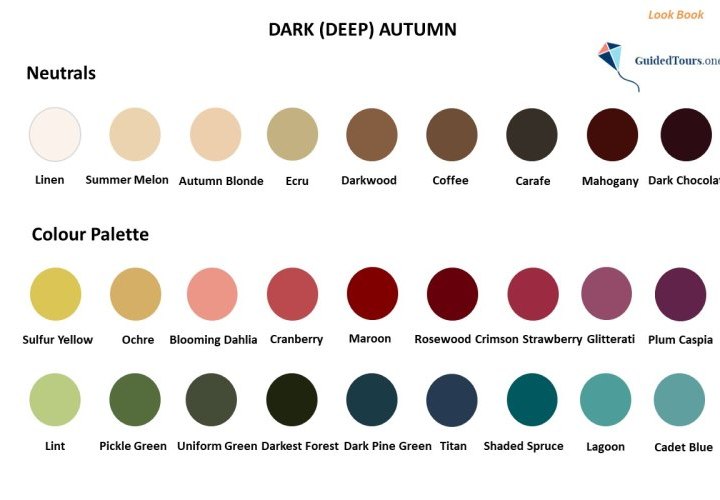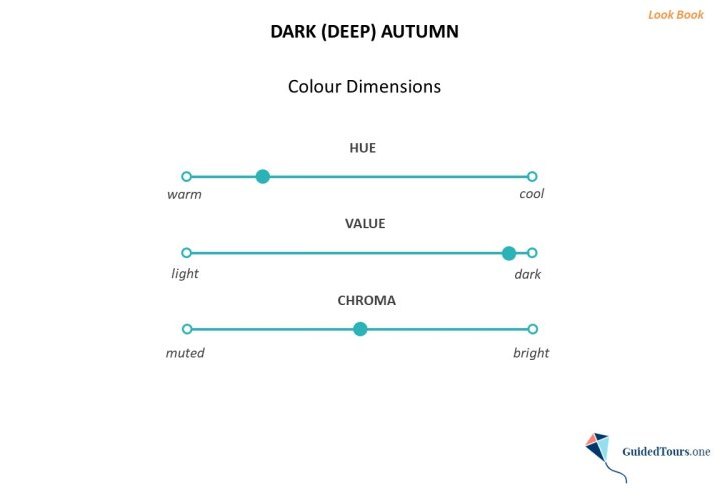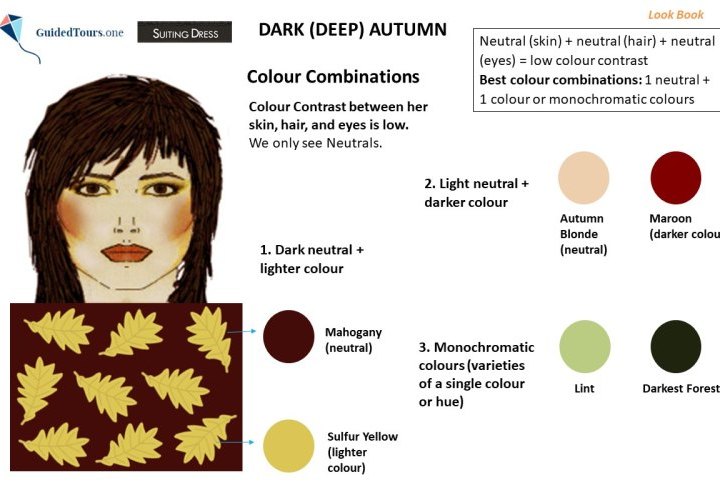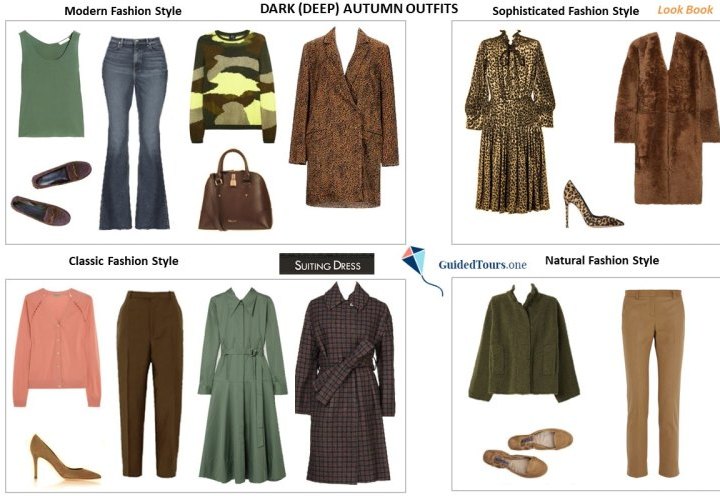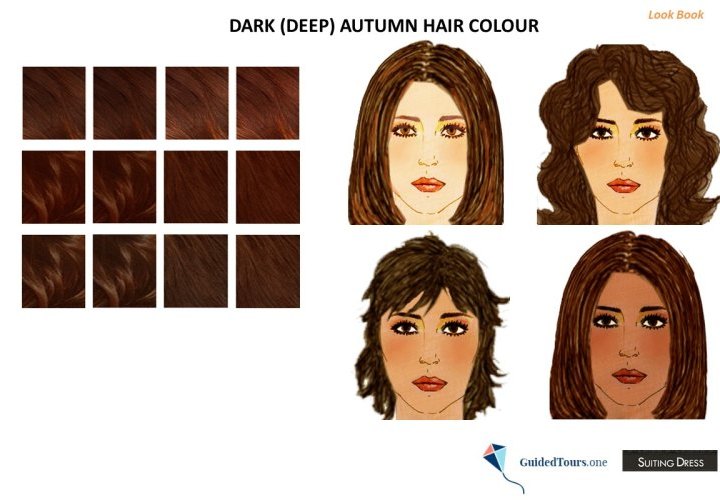Dark (Deep) Autumn is the darkest season of the Autumn family (Soft Autumn, True/Warm Autumn and Dark Autumn) and it sits between True/Warm Autumn and Dark/Deep Winter on the seasonal flow chart. Unlike Dark Winter, which has cool leaning neutral undertones, Dark (Deep) Autumn has warm leaning neutral undertones. This season type is also different from True Autumn, which is completely warm.
If we examine the Colour Dimensions of Dark (Deep) Autumn (image 2) we can see that it is first of all dark, and then it is warm and after that soft.
Hue: Warm/Neutral Warm (the hues of Deep Autumn are primarily warm, but as we can see on the image, they are not extremely warm and can also have some neutral undertones).
Value: Dark/Deep (Dark/Deep Autumn is the darkest season of the Autumn family, more
If we examine the Colour Dimensions of Dark (Deep) Autumn (image 2) we can see that it is first of all dark, and then it is warm and after that soft.
Hue: Warm/Neutral Warm (the hues of Deep Autumn are primarily warm, but as we can see on the image, they are not extremely warm and can also have some neutral undertones).
Value: Dark/Deep (Dark/Deep Autumn is the darkest season of the Autumn family, more
and this is the main colour aspect of this season type).
Chroma: Medium-soft (Deep Autumn has a medium-soft chroma that leans towards the middle of the scale).
Now, let’s examine the features (hair, skin tone, eyes) of Deep Autumn representatives.
Hair: Dark/Deep Autumn hair is dark and can be medium golden brown, dark golden brown, dark auburn, dark brown, and warm brown-black. It may develop golden or red highlights when exposed to the sun.
Skin tone: Dark/Deep Autumn skin has a big range of skin tones, and can be light, medium, tan, dark or deep.
Eye Colours: Dark/Deep Autumn eyes are also dark and are generally dark hazel, dark green, brown and brown-black, but very rarely can also be muted dark blue. The eyes can have both a halo and speckles within the iris and swirling and erratic borders surrounding the pupil. You may also notice the “Aztec Sun” pattern characteristic of Autumn eyes, which is a sun-like shape of mixed warm colours coming out from the pupil like a flame.
Colour Palette
Just like Dark/Deep Autumn’s primary colour dimensions, Dark/Deep Autumn colours are dark, warm, and medium-soft to be in line with this season type natural colouring.
While the overall Deep Autumn Colour Palette (image 1) is dark, there are many colours that are very light.
The colours lean towards the warm end of the scale, and they are the darkest of the autumn family and somewhat soft. The colour palette includes pinks, reds, yellows, purples, blues and greens. Even the blues that you will find in the palette have a tint of yellow to make them warmer. Deep Autumn representatives really “shine” in powerful, deep shades that can overpower other seasons.
At the same time, there are many neutrals in the palette, including linen, autumn blonde, ecru, coffee, and dark chocolate. Dark Autumn neutrals include light neutrals, as well as dark ones. This mixture in value is needed to achieve a high value contrast or a medium-high value contrast, as the contrast between this season type features (you will find more details about this in the next section). Black and white are not included in the palette, but Dark Autumns have their own “version” of black and white in the palette, most often linen and dark chocolate.
Deep Autumn worst colours are light and cool, because they are opposed to dark and warm, the main colour aspects of this season type.
Chroma: Medium-soft (Deep Autumn has a medium-soft chroma that leans towards the middle of the scale).
Now, let’s examine the features (hair, skin tone, eyes) of Deep Autumn representatives.
Hair: Dark/Deep Autumn hair is dark and can be medium golden brown, dark golden brown, dark auburn, dark brown, and warm brown-black. It may develop golden or red highlights when exposed to the sun.
Skin tone: Dark/Deep Autumn skin has a big range of skin tones, and can be light, medium, tan, dark or deep.
Eye Colours: Dark/Deep Autumn eyes are also dark and are generally dark hazel, dark green, brown and brown-black, but very rarely can also be muted dark blue. The eyes can have both a halo and speckles within the iris and swirling and erratic borders surrounding the pupil. You may also notice the “Aztec Sun” pattern characteristic of Autumn eyes, which is a sun-like shape of mixed warm colours coming out from the pupil like a flame.
Colour Palette
Just like Dark/Deep Autumn’s primary colour dimensions, Dark/Deep Autumn colours are dark, warm, and medium-soft to be in line with this season type natural colouring.
While the overall Deep Autumn Colour Palette (image 1) is dark, there are many colours that are very light.
The colours lean towards the warm end of the scale, and they are the darkest of the autumn family and somewhat soft. The colour palette includes pinks, reds, yellows, purples, blues and greens. Even the blues that you will find in the palette have a tint of yellow to make them warmer. Deep Autumn representatives really “shine” in powerful, deep shades that can overpower other seasons.
At the same time, there are many neutrals in the palette, including linen, autumn blonde, ecru, coffee, and dark chocolate. Dark Autumn neutrals include light neutrals, as well as dark ones. This mixture in value is needed to achieve a high value contrast or a medium-high value contrast, as the contrast between this season type features (you will find more details about this in the next section). Black and white are not included in the palette, but Dark Autumns have their own “version” of black and white in the palette, most often linen and dark chocolate.
Deep Autumn worst colours are light and cool, because they are opposed to dark and warm, the main colour aspects of this season type.
Value Contrast
The value (or depth) shows how light or dark a colour is, while the value contrast is the level of difference in value between two or more colours. The closer together colours are, the lower is the level of contrast between them, and the farther apart colours are, the higher is the level of contrast.
Regardless the values of Dark/Deep Autumn representatives features, there is usually a high value contrast or a medium-high value contrast between them. If your skin is darker, the whites of the eyes will provide a high contrast against the dark hair and eyes.
On the image on your right, you can see a Dark Autumn representative with dark hair and eyes and a medium-light skin. In order to determine her value contrast level, more
The value (or depth) shows how light or dark a colour is, while the value contrast is the level of difference in value between two or more colours. The closer together colours are, the lower is the level of contrast between them, and the farther apart colours are, the higher is the level of contrast.
Regardless the values of Dark/Deep Autumn representatives features, there is usually a high value contrast or a medium-high value contrast between them. If your skin is darker, the whites of the eyes will provide a high contrast against the dark hair and eyes.
On the image on your right, you can see a Dark Autumn representative with dark hair and eyes and a medium-light skin. In order to determine her value contrast level, more
we converted her photo into greyscale and assigned a value from 0 to 11 to her hair, skin, and eyes (1 to her hair, 8 to her skin, and 1 to her eyes). Next, we took the highest number and took away the lowest number (8-1=7). According to our value contrast scale that you can see below, she has a medium-high value contrast.
A) 0 - 2 (low value contrast)
B) 3 - 5 (medium-low value contrast)
C) 6 - 8 (medium-high value contrast)
D) 9 - 11 (high value contrast)
The medium-high value contrast, shows us that she can wear contrasted colours with different values and her clothes should not be more than 7 values apart.
Following this example, you can examine your own features and see if there is a high value contrast or a medium-high value contrast between them. Dark/Deep Autumns typically have a high or a medium-high value contrast between their features.
Colour Contrast
In terms of colour contrast, Dark/Deep Autumns typically have a low colour contrast, when all their features are mostly neutral, or a medium-low colour contrast, when two of their features are neutral and one feature has a colour in it.
On the image on your right, you can see that the Colour Contrast of the same Dark/Deep Autumn representative selected by us is low, as we can only see neutrals in her features: neutral hair, neutral skin and neutral eyes. The best colour combinations will be: 1 neutral + 1 colour or monochromatic colours.
Following this example, you can examine your own features and see if there is a low colour contrast or a medium-low colour contrast between them. Dark/Deep Autumns typically have a low or a medium-low colour contrast between their features.
A) 0 - 2 (low value contrast)
B) 3 - 5 (medium-low value contrast)
C) 6 - 8 (medium-high value contrast)
D) 9 - 11 (high value contrast)
The medium-high value contrast, shows us that she can wear contrasted colours with different values and her clothes should not be more than 7 values apart.
Following this example, you can examine your own features and see if there is a high value contrast or a medium-high value contrast between them. Dark/Deep Autumns typically have a high or a medium-high value contrast between their features.
Colour Contrast
In terms of colour contrast, Dark/Deep Autumns typically have a low colour contrast, when all their features are mostly neutral, or a medium-low colour contrast, when two of their features are neutral and one feature has a colour in it.
On the image on your right, you can see that the Colour Contrast of the same Dark/Deep Autumn representative selected by us is low, as we can only see neutrals in her features: neutral hair, neutral skin and neutral eyes. The best colour combinations will be: 1 neutral + 1 colour or monochromatic colours.
Following this example, you can examine your own features and see if there is a low colour contrast or a medium-low colour contrast between them. Dark/Deep Autumns typically have a low or a medium-low colour contrast between their features.
As seen in the previous section, the value contrast between Dark/Deep Autumn features is high or medium-high, while the colour contrast is low or medium-low.
Therefore, Dark Autumn representatives can combine colours with different values (taking into consideration the value contrast number), but the best combinations are those that repeat the value contrast level present in the appearance.
In terms of colour, the best colour combinations for Dark/Deep Autumns with neutral hair, skin and eyes will be 1 neutral and 1 colour or monochromatic colours, while the best colour combination for Dark/Deep Autumns with two neutral features and one feature that has a colour in it will be 2 neutrals and 1 colour or monochromatic colours. This colour combination system was created by us and supposes 4 colour combination possibilities based on each season features colour. more
The best colour combinations for Dark/Deep Autumn representatives (image 1), who have a low colour contrast, are the following:
1. A dark neutral + a lighter colour (1 neutral + 1 colour)
2. A light neutral + a darker colour (1 neutral + 1 colour)
3. Monochromatic colours (varieties of a single colour or hue)
As our Dark/Deep Autumn representative has a medium-high value contrast, all colour combinations were chosen to create the same value contrast and they are 7 values apart.
In terms of prints, the best patterns are those that only contain Dark/Deep Autumn colours, but if you can’t find a print that is completely within your palette, you can opt for a print that also has small colour spots from a disharmonious palette. The autumnal patterns with natural elements such as leaves and wood structures, as well as stylized flowers, oval shapes and unusual and extraordinary effects are great for Dark Autumns. The pattern should include elements that are big and loosely arranged. At the same time, retro geometric patterns with big elements and loose arrangement are also fine.
On the image on your right, you can see an autumnal pattern with big loosely arranged elements (leaves) that contains 1 neutral (mahogany) and 1 colour (sulfur yellow). Besides the appropriate low colour contrast, there is also a medium-high value contrast in this print. If we convert the print into greyscale, we can see that mahogany neutral colour’s value is 0, but sulfur yellow colour’s value is 7. If we take the highest number (7) and take away the lowest number (0) from this print we get 7 (7-0=7), which is also the natural value contrast number of this Dark Autumn representative. As both value and colour contrast are respected, you can notice how harmonious the print looks on the Dark Autumn representative chosen by us.
Dark/Deep Autumns have a sophisticated palette with many options for sophisticated style. On the image on your right (image 2), you can see some Dark Autumn Colour Palette Outfits ideas belonging to modern, sophisticated, classic and natural fashion styles. You can experiment with the colours in your palette to create a high or a medium-high value contrast, and find the style that works better for you (or combine styles).
Therefore, Dark Autumn representatives can combine colours with different values (taking into consideration the value contrast number), but the best combinations are those that repeat the value contrast level present in the appearance.
In terms of colour, the best colour combinations for Dark/Deep Autumns with neutral hair, skin and eyes will be 1 neutral and 1 colour or monochromatic colours, while the best colour combination for Dark/Deep Autumns with two neutral features and one feature that has a colour in it will be 2 neutrals and 1 colour or monochromatic colours. This colour combination system was created by us and supposes 4 colour combination possibilities based on each season features colour. more
The best colour combinations for Dark/Deep Autumn representatives (image 1), who have a low colour contrast, are the following:
1. A dark neutral + a lighter colour (1 neutral + 1 colour)
2. A light neutral + a darker colour (1 neutral + 1 colour)
3. Monochromatic colours (varieties of a single colour or hue)
As our Dark/Deep Autumn representative has a medium-high value contrast, all colour combinations were chosen to create the same value contrast and they are 7 values apart.
In terms of prints, the best patterns are those that only contain Dark/Deep Autumn colours, but if you can’t find a print that is completely within your palette, you can opt for a print that also has small colour spots from a disharmonious palette. The autumnal patterns with natural elements such as leaves and wood structures, as well as stylized flowers, oval shapes and unusual and extraordinary effects are great for Dark Autumns. The pattern should include elements that are big and loosely arranged. At the same time, retro geometric patterns with big elements and loose arrangement are also fine.
On the image on your right, you can see an autumnal pattern with big loosely arranged elements (leaves) that contains 1 neutral (mahogany) and 1 colour (sulfur yellow). Besides the appropriate low colour contrast, there is also a medium-high value contrast in this print. If we convert the print into greyscale, we can see that mahogany neutral colour’s value is 0, but sulfur yellow colour’s value is 7. If we take the highest number (7) and take away the lowest number (0) from this print we get 7 (7-0=7), which is also the natural value contrast number of this Dark Autumn representative. As both value and colour contrast are respected, you can notice how harmonious the print looks on the Dark Autumn representative chosen by us.
Dark/Deep Autumns have a sophisticated palette with many options for sophisticated style. On the image on your right (image 2), you can see some Dark Autumn Colour Palette Outfits ideas belonging to modern, sophisticated, classic and natural fashion styles. You can experiment with the colours in your palette to create a high or a medium-high value contrast, and find the style that works better for you (or combine styles).
Dark/Deep Autumn hair is dark and can be medium golden brown, dark golden brown, dark auburn, dark brown, and warm brown-black. It may develop golden or red highlights when exposed to the sun.
Usually, the best hair colour for Dark/Deep Autumns is their natural hair colour, but if you want to change your natural hair colour, you should opt for another Dark/Deep Autumn hair colour. Remember that your natural colour aspect is first of all dark and warm, and hair colour should also follow your natural colouring. A lighter hair colour (including blonde) can throw off your contrast level and damage your hair.
Advising and choosing a new hair colour is, above all, respecting your high or medium-high contrast level and the natural warm base. more
Usually, the best hair colour for Dark/Deep Autumns is their natural hair colour, but if you want to change your natural hair colour, you should opt for another Dark/Deep Autumn hair colour. Remember that your natural colour aspect is first of all dark and warm, and hair colour should also follow your natural colouring. A lighter hair colour (including blonde) can throw off your contrast level and damage your hair.
Advising and choosing a new hair colour is, above all, respecting your high or medium-high contrast level and the natural warm base. more
Great hair colours for you would be all Dark Autumn hair colours mentioned above, as well as mahogany, deep red or chocolate brown. On the image on your right, you can see how various Dark Autumn representatives look with various warm brown tones. If you like red colours, and would like to opt for a dark red colour, choose the colour with caution and avoid any cool reds. It is important to stay in the same warm category so as not to create disharmony with the complexion.
Dark/Deep Autumns colouring has neutral warm undertones, and gold flatters their skin more than silver. If you are a Dark/Deep Autumn, your best metals will be gold, brass, and bronze with less shine and more depth. If you want to wear silver, choose a darker one that is not too shiny.
In terms of stones, garnet, carnelian, aventurine, heliodor, moldavite, sphene, zoisite and even emerald (a darker one that is not too shiny) are ideal for Dark/Deep Autumn. You can also wear wooden or coloured beads. Matte brown pearls would also look great on Deep Autumns, but we suggest you to opt for faux pearls to show that you care about oysters and molluscs. Pearl extraction is not considered ethical, as oysters and other molluscs only produce pearls as a response to a stressful environment. Faux pearls can be just as beautiful as natural pearls, more
In terms of stones, garnet, carnelian, aventurine, heliodor, moldavite, sphene, zoisite and even emerald (a darker one that is not too shiny) are ideal for Dark/Deep Autumn. You can also wear wooden or coloured beads. Matte brown pearls would also look great on Deep Autumns, but we suggest you to opt for faux pearls to show that you care about oysters and molluscs. Pearl extraction is not considered ethical, as oysters and other molluscs only produce pearls as a response to a stressful environment. Faux pearls can be just as beautiful as natural pearls, more
and they are ethical.
On the image on your right, you can see some pieces of Dark/Deep Autumn jewellery including earrings, rings, and necklaces. Besides taking into consideration what earrings to wear based on your season type, you should also consider the following: 1) what earrings (shape and size) are best for your face shape; 2) how to combine earrings with your dress style (for example modern, classic, sophisticated, etc.).
If you are not sure whether you are a Dark (Deep) Autumn or not, you can contact us for an Online Personal Colour Analysis or purchase the Self Seasonal Colour Analysis Guide (15 €).
On the image on your right, you can see some pieces of Dark/Deep Autumn jewellery including earrings, rings, and necklaces. Besides taking into consideration what earrings to wear based on your season type, you should also consider the following: 1) what earrings (shape and size) are best for your face shape; 2) how to combine earrings with your dress style (for example modern, classic, sophisticated, etc.).
If you are not sure whether you are a Dark (Deep) Autumn or not, you can contact us for an Online Personal Colour Analysis or purchase the Self Seasonal Colour Analysis Guide (15 €).

